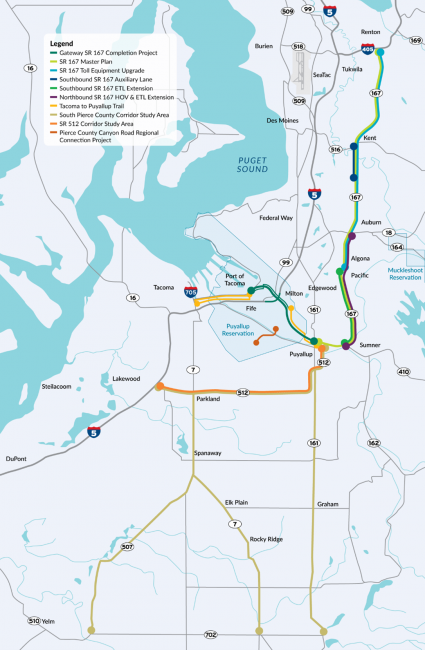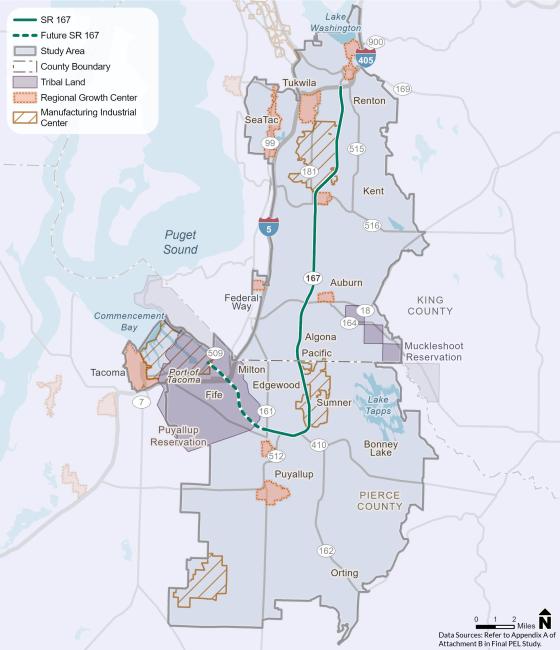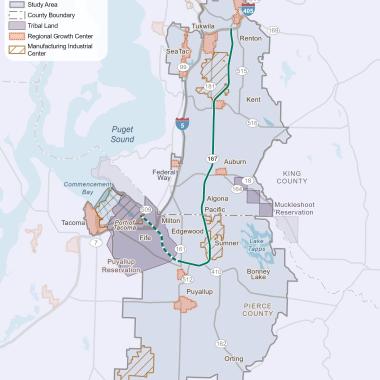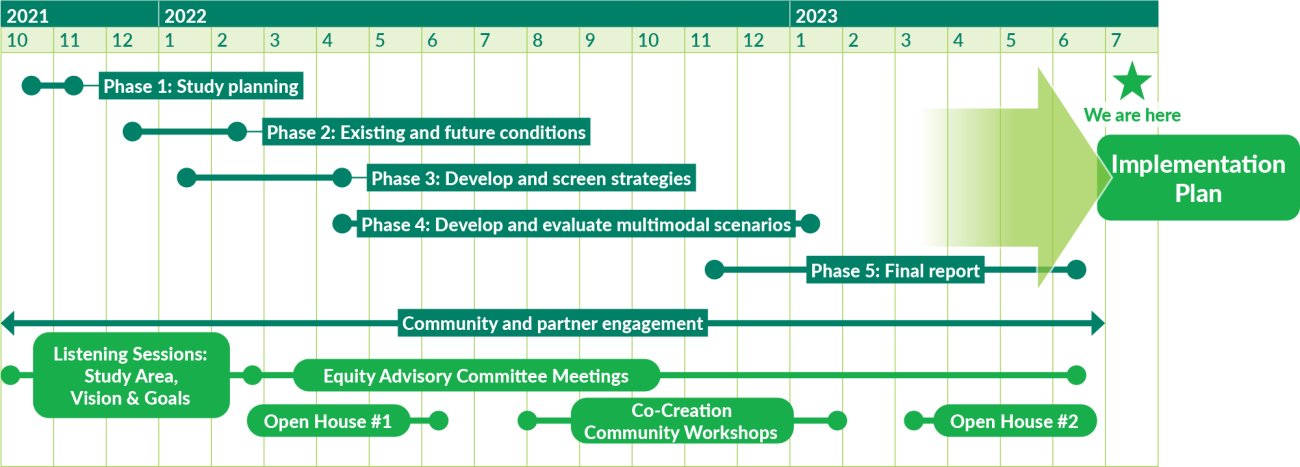Planning study news
The SR 167 Master Plan Planning and Environmental Study, executive summary and appendices are now available.
Purpose
The Puget Sound region is thriving and attracting large population and employment growth. This growth increases strain on our transportation infrastructure and services, resulting in increased traffic congestion and increased needs for maintenance and preservation. There is a need to move people and goods by maximizing the effectiveness of our multimodal transportation system now and into the future.
In response to this need, the Washington Legislature passed Engrossed Substitute Senate Bill 5825, directing $3 million to develop a multimodal SR 167 Master Plan. As part of the SR 167 Master Plan effort, WSDOT analyzed existing and future conditions, incorporated information from public and stakeholder engagement, and identified near, medium, and long-term multimodal transportation needs and strategies along the SR 167 corridor.
The SR 167 Master Plan study area included the existing SR 167 facility from the Port of Tacoma (SR 509) to Renton. WSDOT also considered the local system, and worked with other transportation providers to fully understand needs and solutions in the corridor.
The SR 167 Master Plan Study includes multiple attachments and related appendices
Attachment A (PDF 837KB). SR 167 Master Plan Planning and Environmental Linkages Study Questionnaire
- Appendix A (PDF 336KB). Environmental Resource Next Steps and Implementation Considerations Tables
- Appendix B (PDF 4.9MB). Maps of Environmental Resources with Final Study Recommendations
- Appendix C (PDF 1.1MB). Maps of Vulnerable Populations and Overburdened Communities and Equity Priority Areas
Attachment B (PDF 8.2MB). Existing and Future Baseline Conditions Report
Attachment C (PDF 3.1MB). Scenario Development and Evaluation Report
- Appendix A (PDF 937KB). Projects and Strategies Screening Matrices
Attachment D (PDF 937KB). Final Study Recommendations Report
Attachment E (PDF 555KB). Coordination and Public Participation Summary
- Appendix A (PDF 737KB). FHWA Coordination Points
- Appendix B (PDF 2.4MB). Committee Meetings and Events Summaries
- Appendix C (PDF 761KB). Online Open House Comments
Attachment F (PDF 1.9MB). FHWA Concurrence and Agency Support Letters
The SR 167 corridor runs through the heart of one of the fastest growing areas in the state and includes a diverse set of communities with varying social and economic backgrounds and a mix of businesses and employment opportunities. As the area has grown, so has demand for travel on the SR 167 corridor.
Today, the highway has significant areas of traffic congestion and prior to the pandemic, rapid growth in transit ridership resulted in crowding on some routes and at many of the corridor’s park-and-ride lots. The low-density development in the corridor and a patchy non-motorized network means that the car is the only practical mode for many trips.
Looking forward, the relative affordability of South King and East Pierce County is and will fuel continued housing and employment. Historically, housing development along the corridor included a mix of single-family neighborhoods, infill attached and detached housing, and multifamily communities. Business development included a mix of service – industrial, manufacturing, and warehousing. In recent years, higher density, mixed use developments have emerged at nodes and along connecting roadways near the SR 167 corridor. It is anticipated that both the historic and the emerging development patterns will continue.
The increased density and mix of uses along the corridor will present new opportunities for multimodal travel by residents of these new growth nodes, as well as for the people who live and work in the surrounding lower density areas. Travel in the SR 167 corridor can be transformed by using transportation investments to leverage this growth, exploring new ways to manage single-occupancy vehicle demand and embracing new transportation technologies.
There are other projects and studies happening near the SR 167 corridor. We are coordinating with project leads on these efforts. Those projects include the following:
The I-405 Renton to Bellevue Widening and Express Toll Lanes Project is one project that makes up the I-405/SR 167 Corridor Program.
The Puget Sound Gateway Program is composed of two projects that provide essential connections to the Port of Tacoma and the Port of Seattle and help ensure people and goods move more reliably through the Puget Sound region. Delivering the SR 167 and SR 509 Completion projects under one program allows WSDOT to maximize efficiencies in planning, environmental review, design, and construction.
The SR 167 Completion Project will build the remaining four miles of SR 167 between Meridian and I-5, completing a long-planned connection to I-5. The project also includes a two-mile connection from I-5 to the Port of Tacoma.
SR 167 - SR 410 to SR 18 NB Congestion Management
WSDOT is adding an additional northbound HOV lane within the existing pavement width that will begin near State Route 410 in Pierce County and continue north tying into the existing SR 167 HOT Lane near Auburn in King County. Once construction is complete, the additional lane will open as a HOV lane and transition to an Express Toll Lane (ETL) at a future date.
The SR 167 high occupancy toll (HOT) lanes, opened in 2008, are high occupancy vehicle (HOV) lanes open to solo drivers who choose to pay a toll. Carpools of two or more, vanpools and buses use the lanes toll-free. Toll rates adjust to ensure traffic in the HOT lane is free-flowing even when the regular lanes are congested. The SR 167 HOT lanes help keep traffic moving by providing a choice for a faster, more reliable trip when you need it most.

As part of the Puget Sound Gateway Program, WSDOT opened the shared-use path on the new Wapato Way East Bridge over I-5 in Fife in July 2021. The path opening comes on the heels of opening the new bridge and SR 99 roundabout to traffic in late June 2021. The 12-foot-wide path on the new bridge provides new access for those who walk and roll, with direct connections to the Interurban Trail and new SR 99 sidewalks and crosswalks.
A map of the SR 167 Master Plan study area is below. The study area boundary was expanded to include some nearby areas of regional significance including regional growth centers and regional manufacturing and industrial growth centers. The study area boundary was drawn to account for some geographic barriers, and it was adjusted to follow some city limit and census block group boundaries to ensure WSDOT captures whole communities.

As part of this study, we will work with the communities on/along the corridor to establish a multimodal vision for the SR 167 Master Plan and include the following key actions:
- Outline a multi-agency plan for action.
- Include community and partner engagement.
- Build upon existing or planned project work.
- Evaluate preservation and maintenance needs.
- Evaluate safety needs and ensure consistency with WSDOT’s target zero highway safety plan.
- Use WSDOT’s Practical Solutions-based framework for decision making.
- Consider future growth and land use.
- Focus on multimodal transportation choices before capital investments.
- Apply the Planning and Environmental Linkages (PEL) approach.
- Implement the Healthy Environment for All Act (HEAL Act of 2021).
Building upon the existing partnerships developed through the I-405/SR 167 Program and Puget Sound Gateway Program executive committees, we will convene a policy advisory committee and technical advisory committee for the SR 167 Master Plan effort. Membership will include local jurisdictions, tribes, transit agencies, businesses, and other regional partners. Community engagement along SR 167 will also occur throughout the planning process. You can view materials from our committee meetings below.
Equity Advisory Committee
Equity Advisory Committee Meeting 1
Friday, Feb. 25, 2022
Presentation (PDF 2MB)
Equity Advisory Committee Meeting 2
Friday, April 22, 2022
Presentation (PDF 2MB)
Equity Advisory Committee Meeting 3
Friday, June 10, 2022
Presentation (PDF 1MB)
Equity Advisory Committee Meeting 4
Friday, Sept. 23, 2022
Presentation (PDF 750KB)
Equity Advisory Committee Meeting 5
Friday, Nov. 18, 2022
Presentation (PDF 2MB)
Equity Advisory Committee Meeting 6
Friday, March 3, 2023
Presentation (PDF 2MB)
Policy Advisory Committee
Policy Advisory Committee Meeting 1
Wednesday, Nov. 17, 2021
Presentation (PDF 716KB)
Summary (PDF 73KB)
Policy Advisory Committee Meeting 2
Wednesday, Feb. 2, 2022
Presentation (PDF 1MB)
Summary (PDF 93KB)
Policy Advisory Committee Meeting 3
Wednesday, May 4, 2022
Presentation (PDF 1MB)
Summary (PDF 83KB)
Policy Advisory Committee Meeting 4
Wednesday, July 13, 2022
Presentation (PDF 1MB)
Summary (PDF 136KB)
Policy Advisory Committee Meeting 5
Wednesday, Nov. 30, 2022
Presentation (PDF 2MB)
Summary (PDF 160KB)
Technical Advisory Committee
Technical Advisory Committee Meeting 1
Wednesday, Nov. 10, 2021
Presentation (PDF 810KB)
Summary (PDF 128KB)
Technical Advisory Committee Meeting 2
Wednesday, Jan. 19, 2022
Presentation (PDF 811KB)
Summary (PDF 165KB)
Technical Advisory Committee Meeting 3
Wednesday, March 30, 2022
Presentation (PDF 1MB)
Summary (PDF 190KB)
Technical Advisory Committee Meeting 4
Wednesday, June 29, 2022
Presentation (PDF 2MB)
Summary (PDF 339KB)
Technical Advisory Committee Meeting 5
Wednesday, Nov. 9, 2022
Presentation (PDF 3MB)
Summary (PDF 127KB)


